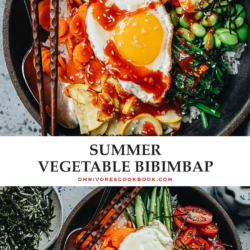This summer vegetable bibimbap recipe is sponsored by Pete & Gerry’s eggs. All opinions expressed are my own. Thank you for supporting the companies that keep this blog going.

Summer vegetable bibimbap is loaded with colorful and bright seasonal vegetables and sunnyside egg, and brought together with a spicy sweet chili sauce. {Vegetarian, Gluten-Free Adaptable}
Bibimbap is one of Korea’s representative rice dishes and a staple of Korean cuisine. It usually consists of steamed rice topped with seasoned veggies, sliced meat, and an egg yolk with chili pepper paste. It is usually served in a super hot heavy stone bowl. When you start to eat, you mix everything together and you can hear the rice and other ingredients sizzling.
In this post, I want to share a vegetable bibimbap recipe that is perfect for summer. For my bibimbap bowl, I used plenty of summer vegetables such as cucumber, summer squash, spinach, carrot and tomato. It is also served in a regular bowl instead of the hot stone bowl, which makes it much nicer on a warm day.
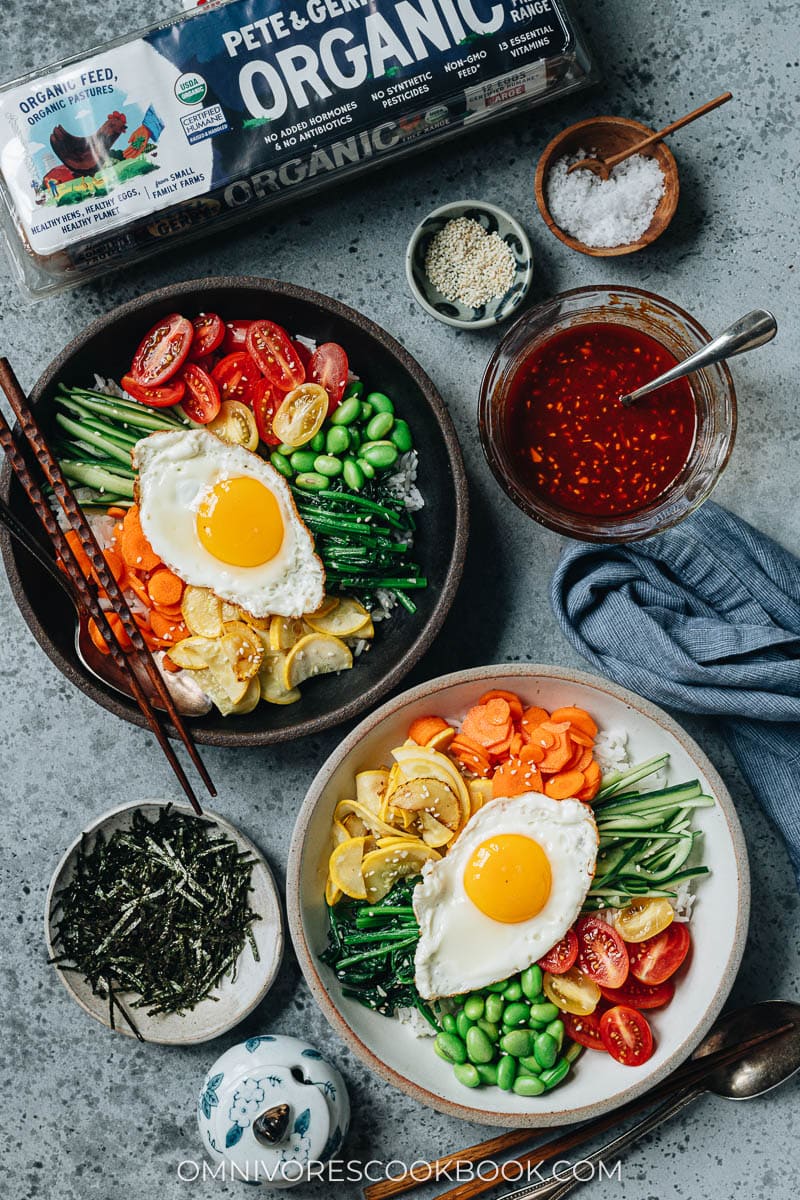
Why this recipe
- Instead of cooking all the vegetables by stir frying or blanching, I used a quick pickling process to prepare some of them so they taste bright and fresh.
- For the cooked vegetables, I tried my best to simplify the ingredients and process without compromising on taste.
- The bibimbap sauce is spicy yet well balanced and full of flavor. I made it a bit more tangy than the traditional version, so it works perfectly with the summer vegetables.
Ingredients
My vegetable bibimbap contains a lot of colorful summer vegetables:
- Carrot
- Summer squash
- Cherry
- Cucumber
- Spinach
- Edamame
The seasonings and toppings includes:
- A rice vinegar pickling mixture that is slightly sweet
- Gochujang chili garlic sauce
- Eggs
- Toasted sesame seeds
- Shredded seaweed
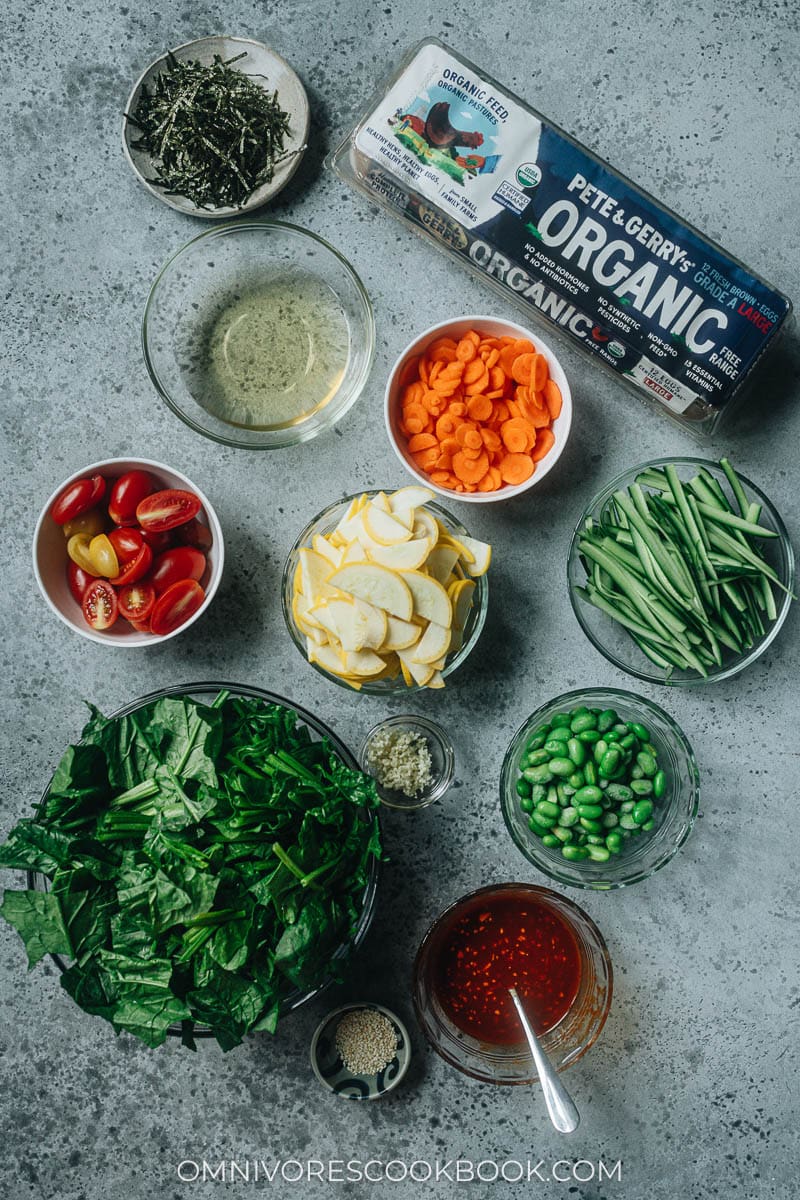
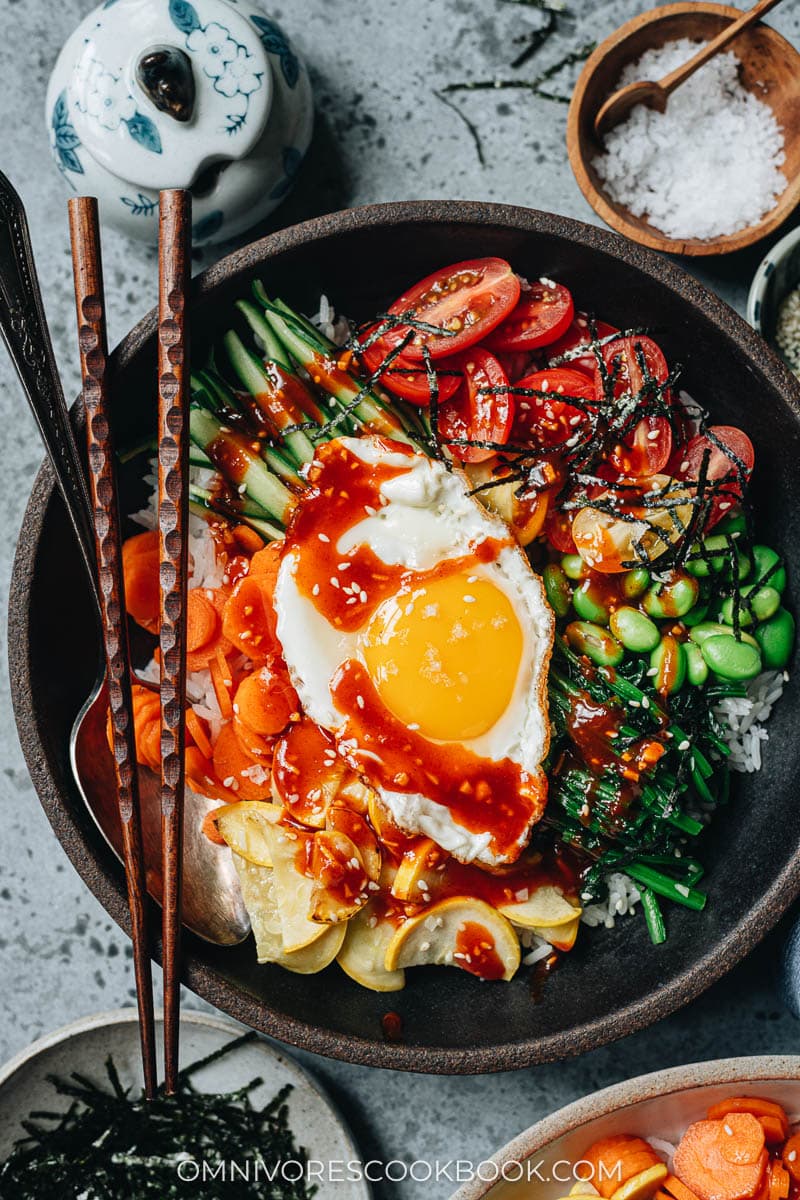
Use high quality eggs
I love to use Pete & Gerry’s eggs in my vegetable bibimbap. Their organic eggs are USDA-certified and produced without GMOs, synthetic pesticides, antibiotics, or hormones. Unlike what you’ll find at mass-production facilities run by big corporations (read: many store brand eggs, among others), their hens are truly humanely treated, and have access to outdoor pastures with room to roam. You’ll notice that their eggshells are much thicker and the yolks have a more vibrant yellow color. These eggs are super flavorful, which is perfect for a light summer dish paired with crisp veggies.
How to cook summer vegetable bibimbap
- Make quick pickles
I used a very easy pickling liquid that contains vinegar, sugar, and a bit of salt to marinate the carrot. The same liquid is also used with the cucumber and tomato to make a quick salad.
This process is very fast and easy, yet it gives the vegetables a ton of flavor without the need to cook and season them separately.
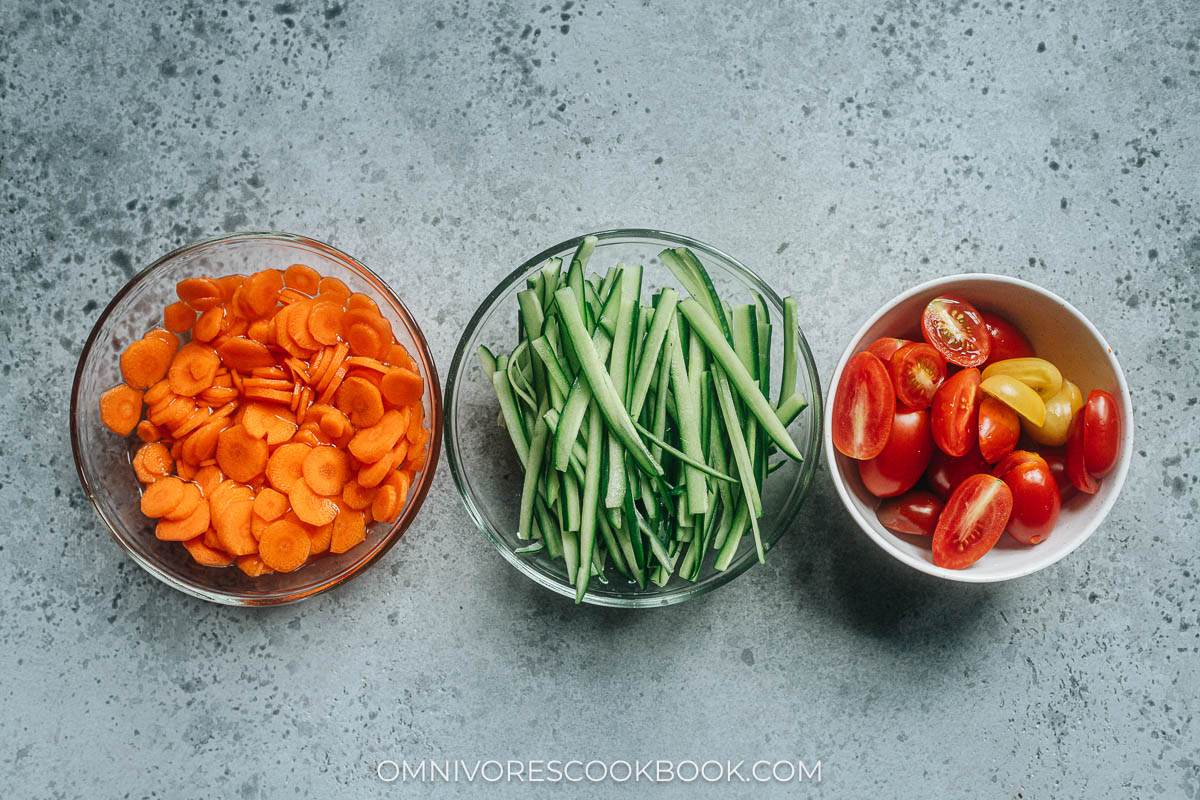
- Prepare the cooked vegetables and eggs
- Gently saute some garlic
- Stir fry the summer squash with a pinch of salt and sesame oil until lightly caramelized
- Cook the spinach in the same way
- Make sunny side up eggs
For a traditional bibimbap dish, the spinach is usually blanched and seasoned separately. I decided to cook it on the stove as well to further streamline the cooking process.
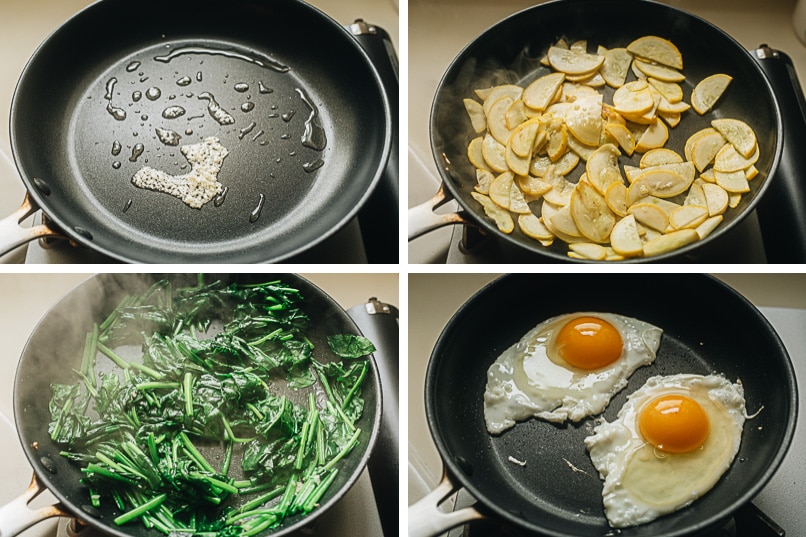
- Make the chili garlic sauce
I made a bit more sauce in case you need it. But if you do not like your vegetable bibimbap to be too spicy, you can further reduce the gochujang to 2 tablespoons instead of 3. You should also add a little bit of sauce at a time, to make sure the spice level works for you.
- Assemble the bowl
I used steamed jasmine rice for my bowl. Feel free to replace the rice with a short grain rice or brown rice, however you prefer.
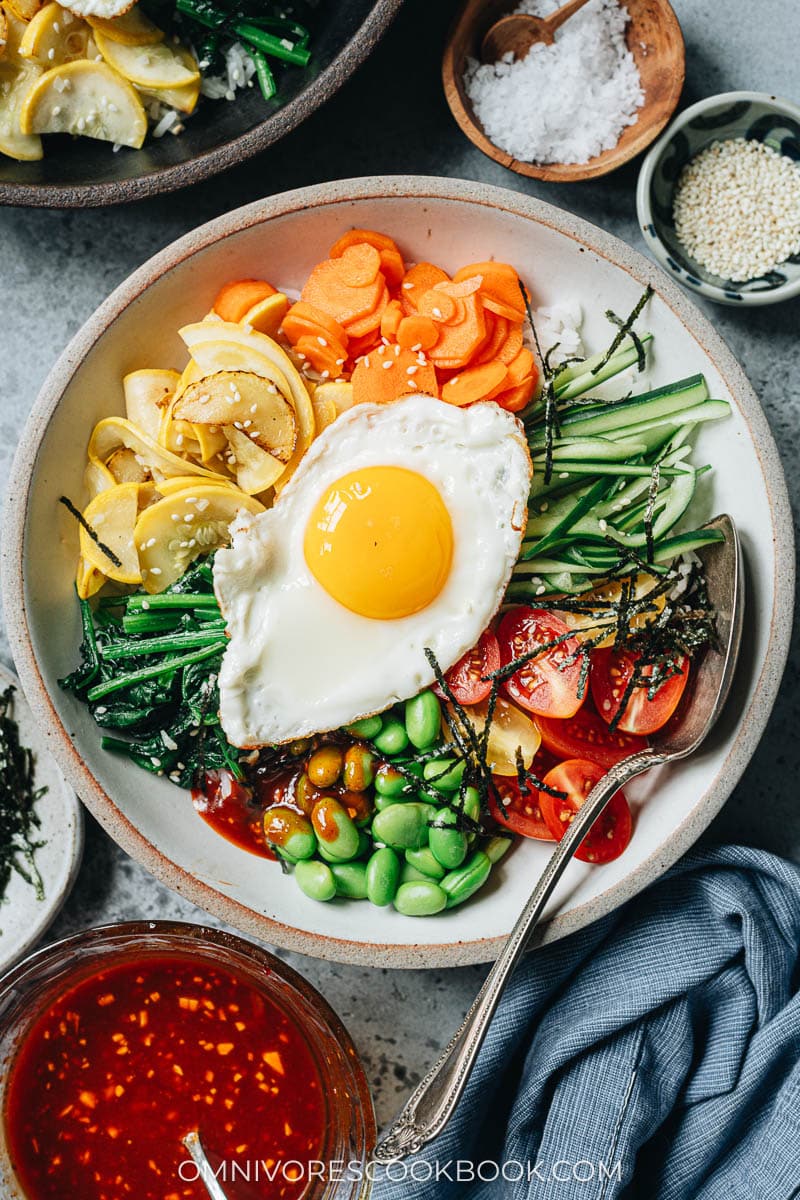
How to use different vegetables
You can use different vegetables in these summer bibimbap bowls. Here are some examples:
- Carrot: use radish, purple onions or shallot, prepared the same way
- Cucumber: bean sprouts, stir fried with a pinch of salt and sesame oil
- Summer squash: zucchini, prepared the same way
- Spinach: chard or kale, prepared the same way but it will need longer cooking time
- Edamame: green peas or pan fried tofu
Afterthoughts
The ingredient list for this summer vegetable bibimbap bowl might look quite long. But trust me, most of the ingredients are quite easy to prepare. Once you cut all the ingredients, it takes no time to cook and put them together.
If you’re visiting farmers markets this weekend, grab whatever looks the best and use this recipe to enjoy some summer vegetables!

More delicious vegetable recipes
- Vegetable Pan Fried Noodles
- Vegetable Fried Rice (蔬菜炒饭)
- Chinese Spinach Salad with Peanuts (老醋菠菜花生)
- Air Fryer Chinese Eggplant
- Air Fryer Garlic Green Beans
- Chinese Okra Salad, Two Ways (凉拌秋葵)
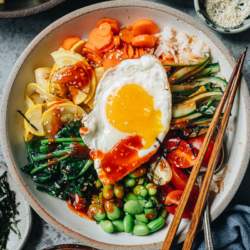
Summer Vegetable Bibimbap
Ingredients
Pickling ingredients
- 1/2 cup rice vinegar
- 3 teaspoons sugar
- Pinch of salt
For the bowl
- 1 (4 oz / 120 g) small carrot , sliced
- 1 English cucumber , seeds removed and julienned
- 1 cup boiled shelled edamame , thawed if using frozen edamame
- 1 tablespoon peanut oil (or vegetable oi)
- 2 cloves garlic , minced
- 1 (5 oz / 150 g) summer squash , sliced to half-moon shape
- 1/2 lb (225 g) spinach , cut to 2” (4 cm) pieces
- 1 cup cherry tomatoes , halved
- 1/2 teaspoon salt (or to taste)
- 1 teaspoon toasted sesame oil
- 3 to 4 cups steamed rice (*Footnote 1)
- 4 Pete & Gerry’s eggs
- Shredded toasted seaweed (for garnish)
- Toasted sesame seeds (for garnish)
Bibimbap sauce
- 3 tablespoons gochujang
- 1 tablespoon sesame oil
- 1 1/2 tablespoons maple syrup (or sugar)
- 1 tablespoon rice vinegar
- 2 teaspoons soy sauce
- 1 clove garlic , minced
Instructions
Make the pickles
- Combine the rice vinegar, sugar, and salt in a small pot. Heat over medium heat until the brine reaches a boil. Whisk to make sure the sugar dissolves thoroughly. Once done, transfer the pickling liquid to a tupperware container or a medium-sized bowl to cool.
- Once the pickling liquid is mostly cooled (it’s fine if it’s lukewarm), transfer 1 tablespoon of the brine to the bowl of cucumber. And transfer another 1 tablespoon of the brine to the tomato. Mix well separately. Add the rest of the brine to the carrot. Let marinate for 20 minutes while preparing the rest of the ingredients.
- Once done, drain the marinating liquid from the carrots.
Prepare the vegetables and eggs
- Heat 1/2 tablespoon of the peanut oil in a medium-sized pan over medium-high heat until hot. Add half of the garlic and stir a few times to release the fragrance. Add the summer squash. Stir a few times to coat well with the oil. Add 1/4 teaspoon teaspoon of salt. Stir until softened. Drizzle with 1/2 teaspoon sesame oil. Mix well and transfer to a plate to cool.
- Cook the spinach the same way you made the summer squash.
- Fry the eggs until sunny side up or over easy, according to your preference.
Mix the sauce
- Combine all the sauce ingredients in a small bowl and stir to mix well. (*Footnote 2)
To assemble the bowl
- Divide the rice into four serving bowls. Add the vegetables, edamame, and an egg on top of each bowl. Add a spoonful of sauce and garnish with seaweed and sesame seeds. Serve with soy sauce or salt, and extra sauce on the side, in case you need to adjust the seasoning.
- To eat, mix everything together and enjoy.
Notes
- This recipe can make 3 regular servings or 4 small servings.
- If you don’t like a spicy sauce, use 2 tablespoons of gochujang instead of 3.













